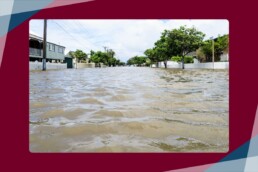What You Need to Know About Flood Insurance in NJ
Key Takeaways
- Flood insurance is essential for New Jersey homeowners, even those outside high-risk zones, as flooding can occur anywhere from various sources like heavy rains and rapid snowmelt.
- Homeowners insurance does not cover flood damage, so you must purchase a separate flood insurance policy through NFIP or private insurers.
- Private flood insurance can offer broader coverage and higher limits than NFIP, often providing more comprehensive protection for high-value properties.
- Affordable flood insurance options exist for low-risk areas, with premiums starting at under $200 annually, making it a cost-effective safeguard.
Flood zones in New Jersey extend far beyond coastal areas, encompassing inland regions that may also be susceptible to flooding. According to FEMA, approximately 41 million Americans live in high-risk flood zones known as Special Hazard Flood Areas (SHFA). Flooding can result from various sources such as heavy rainfall, rapid snowmelt, and overflowing rivers, not just proximity to bodies of water.
Even a few inches of water can cause extensive damage to a home’s structure and personal belongings, making flood insurance a critical safeguard for homeowners across the state.
The Difference Between Homeowners Insurance and Flood Insurance
Why Standard Home Insurance Doesn’t Cover Flooding
A common misconception among homeowners is that standard home insurance policies cover flood damage. However, most homeowners policies explicitly exclude flood-related damage, leaving properties vulnerable in the event of a flood. While some insurers may offer flood coverage as an endorsement to a home policy, this is rare. Flood insurance is designed as a separate policy that provides coverage for water damage caused by natural flooding events.
When Flood Insurance Is Required in NJ
Flood insurance is mandatory for homeowners whose properties are in high-risk flood zones and have a mortgage from a federally regulated lender. However, even homes located in moderate- to low-risk zones can benefit from flood insurance, as 30% of flood-related damages occur outside of designated high-risk areas. Consulting the official FEMA flood map can help homeowners determine their property’s risk level and the proximity of high-risk zones.
Types of Flood Insurance Available in NJ
National Flood Insurance Program (NFIP)
The NFIP, administered by FEMA, provides flood insurance policies with standardized coverage limits. Homeowners can obtain up to $250,000 in coverage for the structure of the home and $100,000 for personal belongings. These policies are accessible through independent insurance agents and are often required for homes in designated flood zones.
Private Flood Insurance
Private flood insurance has gained popularity due to its broader coverage options and higher policy limits compared to NFIP policies. Private insurers often offer coverage above the NFIP limits, making them suitable for homeowners with high-value properties. Additionally, private policies may include coverage for temporary living expenses, detached structures, and other enhancements not provided by NFIP.
Why Consider Flood Insurance Even If You’re Not in a Flood Zone
Flood Risks Extend Beyond Coastal Areas
Flooding can occur anywhere due to factors like heavy rains, poor drainage, and infrastructure failures. Homeowners in non-coastal areas may face unexpected flooding from backed-up sewers, rapid snowmelt, or urban runoff. Flood insurance provides financial protection by covering repairs, replacements, and restoration efforts, reducing the financial burden on homeowners.
Affordable Coverage for Low-Risk Areas
For homes in low- to moderate-risk flood zones, flood insurance premiums are often much lower than those in high-risk areas, with some policies starting at under $200 annually. This affordable coverage ensures that homeowners are protected from unforeseen flood damage without significant financial strain.
What Flood Insurance Covers (and What It Doesn’t)
Events and Damages Covered
Flood insurance typically covers damages caused by:
- Overflowing rivers and streams
- Coastal storm surges
- Heavy rainfall leading to surface water accumulation
- Rapid snowmelt
Covered damages include structural repairs, electrical and plumbing systems, HVAC systems, household appliances, carpeting, and personal belongings.
Exclusions to Be Aware Of
Flood insurance does not cover all types of water damage. Exclusions include damage from sewer backups (unless added to the policy), gradual water seepage, moisture or mold not caused by a covered flood event, and landscaping or vehicles.
How to Choose the Right Flood Insurance Policy in NJ
Assessing Your Flood Risk
A thorough assessment of flood risk involves reviewing FEMA flood maps, understanding the history of flooding in your area, and considering future climate trends. Working with an experienced insurance agent can help you identify the best policy for your home’s risk level and location.
Comparing NFIP and Private Flood Insurance Options
Homeowners should compare the benefits and limitations of NFIP and private flood insurance policies. Factors to consider include coverage limits, premium costs, deductibles, and additional coverage options such as temporary living expenses and property upgrades.
Tips for Reducing Flood Insurance Premiums
Elevate Your Home
Raising the elevation of your home can reduce flood risk and lower premiums. Homes built above the Base Flood Elevation (BFE) are often eligible for lower rates.
Install Flood Vents
Flood vents allow water to flow through enclosed areas like basements or crawl spaces, minimizing structural damage and lowering insurance costs.
Maintain Proper Drainage
Ensuring proper drainage systems around your property prevents water accumulation and reduces the likelihood of flooding, potentially lowering insurance premiums.
Final Thoughts on Flood Insurance in NJ
Flood insurance is a valuable investment that protects homeowners from the financial devastation of flood damage. With various options available through NFIP and private insurers, New Jersey homeowners can find affordable coverage that meets their needs. Regularly reviewing and updating your flood insurance policy ensures that your home remains protected against evolving risks and unexpected flood events.
FAQs
1. What is the difference between NFIP and private flood insurance?
NFIP is a federal program with standardized coverage limits, while private flood insurance often offers higher limits, broader coverage, and more flexible options.
2. Is flood insurance mandatory in New Jersey?
Flood insurance is mandatory for homes in high-risk flood zones with federally backed mortgages, but it is optional for homes in moderate- to low-risk areas.
3. What does flood insurance cover?
Flood insurance covers structural damage, electrical and plumbing systems, appliances, and personal belongings from events like overflowing rivers, storm surges, and heavy rainfall.
4. How can I lower my flood insurance premiums?
Raising your home’s elevation, installing flood vents, and maintaining proper drainage can help reduce flood risk and lower insurance premiums.
Related Articles
Flood Zone and Flood Insurance Myths, Debunked
Floods pose an immense danger to both people and property no matter what the situation is. This is not only evident in low-lying areas where you have a lot of…

